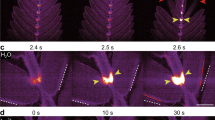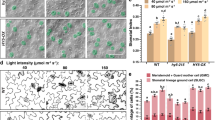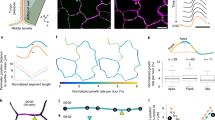Abstract
VARIOUS higher plants make rapid movements in response to stimuli1–3, among them Mimosa which rapidly closes its leaves when touched. We wish to report a series of experiments demonstrating such fast closure in response to light alone. Usually, light causes opening of the leaves, although it is known that after a few hours in the dark, light (< 550 nm) will cause the petiole to fall rapidly4,5.
This is a preview of subscription content, access via your institution
Access options
Subscribe to this journal
Receive 51 print issues and online access
$199.00 per year
only $3.90 per issue
Buy this article
- Purchase on Springer Link
- Instant access to full article PDF
Prices may be subject to local taxes which are calculated during checkout
Similar content being viewed by others
References
Lloyd, F. E., The Carnivorous Plants (Ronald Press, New York, 1942).
Ball, N. G., in Physiology of Plant Growth and Development (edit. by Wilkins, M.) (McGraw-Hill, New York, 1969).
Sibaoka, T., Ann. Rev. Plant Physiol., 20, 165 (1969).
Fondeville, J. C., Borthwick, H. A., and Hendricks, S. B., Planta, 69, 357 (1966).
Fondeville, J. C., Schneider, M. J., Borthwick, H. A., and Hendricks, S. B., Planta, 75, 228 (1967).
Galston, A., and Satter, R., Rec. Adv. Phytochem., 4 (in the press).
Author information
Authors and Affiliations
Rights and permissions
About this article
Cite this article
APPLEWHITE, P., GARDNER, F. Rapid Leaf Closure of Mimosa in Response to Light. Nature 233, 279–280 (1971). https://doi.org/10.1038/233279a0
Received:
Revised:
Issue Date:
DOI: https://doi.org/10.1038/233279a0
This article is cited by
-
On the Conditioning of Plants: A Review of Experimental Evidence
Perspectives on Behavior Science (2018)
Comments
By submitting a comment you agree to abide by our Terms and Community Guidelines. If you find something abusive or that does not comply with our terms or guidelines please flag it as inappropriate.



